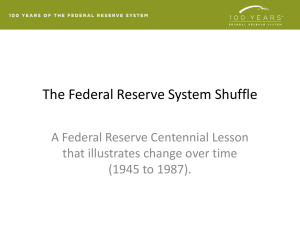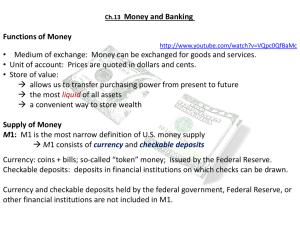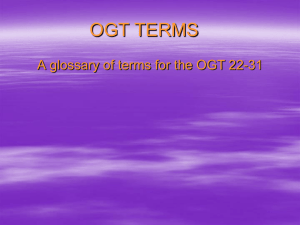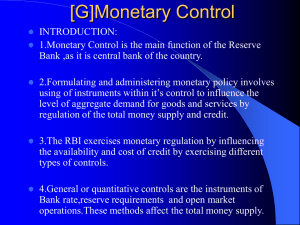RESERVE BANK OF INDIA - DAV College For Girls, Yamunanagar
advertisement
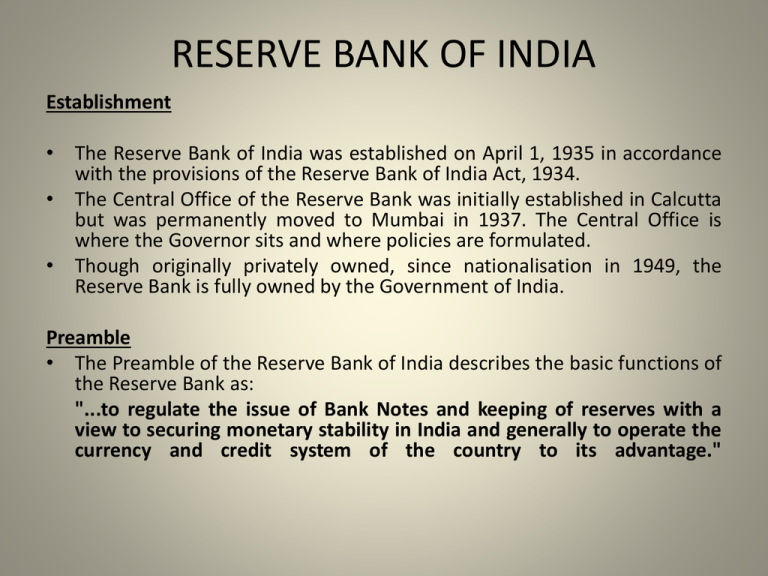
RESERVE BANK OF INDIA Establishment • The Reserve Bank of India was established on April 1, 1935 in accordance with the provisions of the Reserve Bank of India Act, 1934. • The Central Office of the Reserve Bank was initially established in Calcutta but was permanently moved to Mumbai in 1937. The Central Office is where the Governor sits and where policies are formulated. • Though originally privately owned, since nationalisation in 1949, the Reserve Bank is fully owned by the Government of India. Preamble • The Preamble of the Reserve Bank of India describes the basic functions of the Reserve Bank as: "...to regulate the issue of Bank Notes and keeping of reserves with a view to securing monetary stability in India and generally to operate the currency and credit system of the country to its advantage." Central Board • The Reserve Bank's affairs are governed by a central board of directors. The board is appointed by the Government of India in keeping with the Reserve Bank of India Act. • Appointed/nominated for a period of four years • Constitution: – Official Directors • Full-time : Governor and not more than four Deputy Governors – Non-Official Directors • Nominated by Government: ten Directors from various fields and two government Officials • Others: four Directors - one each from four local boards Functions : General superintendence and direction of the Bank's affairs Local Boards • One each for the four regions of the country in Mumbai, Calcutta, Chennai and New Delhi • Membership: • consist of five members each • appointed by the Central Government for a term of four years • Functions : To advise the Central Board on local matters and to represent territorial and economic interests of local cooperative and indigenous banks; to perform such other functions as delegated by Central Board from time to time. Functions : To advise the Central Board on local matters and to represent territorial and economic interests of local cooperative and indigenous banks; to perform such other functions as delegated by Central Board from time to time. STRUCTURE Central Board of Directors • • • The Central Board of Directors is the main committee of the central bank. The Government of India appoints the directors for a four-year term. The Board consists of a governor, four deputy governors, fifteen directors to represent the regional boards, one from the Ministry of Finance and ten other directors from various fields. Governors The current Governor of RBI is Raghuram Rajan. There are four deputy governors, Deputy Governor K C Chakrabarty,Anand Sinha , H R Khan and Urjit Patel . Deputy Governor K C Chakrabarty's term has been extended further by 2 years. Subir Gokarn was replaced by Urjit Patel in January 2013. Supportive bodies • The Reserve Bank of India has ten regional representations: North in New Delhi, South in Chennai, East in Kolkata and West in Mumbai. The representations are formed by five members, appointed for four years by the central government and serve—beside the advice of the Central Board of Directors—as a forum for regional banks and to deal with delegated tasks from the central board. The institution has 22 regional offices. • The Board of Financial Supervision (BFS), formed in November 1994, serves as a CCBD committee to control the financial institutions. It has four members, appointed for two years, and takes measures to strength the role of statutory auditors in the financial sector, external monitoring and internal controlling systems. • Offices and branches • The Reserve Bank of India has four zonal offices. It has 19 regional offices at most state capitals and at a few major cities in India. Few of them are located in Ahmedabad, Bangalore, Bhopal, Bhubaneswar, Chandigarh, Chennai, Delhi, Guwahati, Hyderabad, Jaipur, Jammu, Kanpur, Kolkata, Lucknow, Mumbai, Nagpur, Patna, and Thiruvananthapuram. It also has 9 sub-offices located in Agartala, Dehradun, Gangtok, Kochi, Panaji, Raipur, Ranchi, Shillong, Shimla and Srinagar. • The bank has also two training colleges for its officers, viz. Reserve Bank Staff College at Chennai and College of Agricultural Banking at Pune. There are also four Zonal Training Centres at Mumbai, Chennai, Kolkata and New Delhi. Training Establishments • Has five training establishments • Two, namely, College of Agricultural Banking and Reserve Bank of India Staff College are part of the Reserve Bank • Others are autonomous, such as, National Institute for Bank Management, Indira Gandhi Institute for Development Research (IGIDR), Institute for Development and Research in Banking Technology (IDRBT) Subsidiaries • Fully owned: Deposit Insurance and Credit Guarantee Corporation of India(DICGC), Bharatiya Reserve Bank Note Mudran Private Limited(BRBNMPL) FUNCTIONS OF RBI • • • • • • • • • • • • • • • • • • Main Functions Monetary Authority: Formulates, implements and monitors the monetary policy. Objective: maintaining price stability and ensuring adequate flow of credit to productive sectors. Regulator and supervisor of the financial system: Prescribes broad parameters of banking operations within which the country's banking and financial system functions. Objective: maintain public confidence in the system, protect depositors' interest and provide costeffective banking services to the public. Manager of Foreign Exchange Manages the Foreign Exchange Management Act, 1999. Objective: to facilitate external trade and payment and promote orderly development and maintenance of foreign exchange market in India. Issuer of currency: Issues and exchanges or destroys currency and coins not fit for circulation. Objective: to give the public adequate quantity of supplies of currency notes and coins and in good quality. Developmental role Performs a wide range of promotional functions to support national objectives. Related Functions Banker to the Government: performs merchant banking function for the central and the state governments; also acts as their banker. Banker to banks: maintains banking accounts of all scheduled banks. Main functions • • • • • • Bank of Issue Under Section 22 of the Reserve Bank of India Act, the Bank has the sole right to issue bank notes of all denominations.(one rupee note and coin, which are issued by Ministry of finance) The distribution of one rupee notes and coins and small coins all over the country is undertaken by the Reserve Bank as agent of the government. The Reserve Bank has a separate Issue Department which is entrusted with the issue of currency notes. The assets and liabilities of the Issue Department are kept separate from those of the Banking Department. Monetary authority The Reserve Bank of India is the main monetary authority of the country and beside that the central bank acts as the bank of the national and state governments. It formulates, implements and monitors the monetary policy as well as it has to ensure an adequate flow of credit to productive sectors. Regulator and supervisor of the financial system The institution is also the regulator and supervisor of the financial system and prescribes broad parameters of banking operations within which the country's banking and financial system functions. Its objectives are to maintain public confidence in the system, protect depositors' interest and provide cost-effective banking services to the public. The Banking Ombudsman Scheme has been formulated by the Reserve Bank of India (RBI) for effective addressing of complaints by bank customers. The RBI controls the monetary supply, monitors economic indicators like the gross domestic product and has to decide the design of the rupee banknotes as well as coins. • • • Managerial of exchange control The central bank manages to reach the goals of the Foreign Exchange Management Act, 1999. Objective: to facilitate external trade and payment and promote orderly development and maintenance of foreign exchange market in India. Issuer of currency The bank issues and exchanges or destroys currency notes and coins that are not fit for circulation. The objectives are giving the public adequate supply of currency of good quality and to provide loans to commercial banks to maintain or improve the GDP. The basic objectives of RBI are to issue bank notes, to maintain the currency and credit system of the country to utilize it in its best advantage, and to maintain the reserves. RBI maintains the economic structure of the country so that it can achieve the objective of price stability as well as economic development, because both objectives are diverse in themselves. Banker of Banks Nagpur branch holds most of India's gold deposits RBI also works as a central bank where commercial banks are account holders and can deposit money.RBI maintains banking accounts of all scheduled banks. Commercial banks create credit. It is the duty of the RBI to control the credit through the CRR, bank rate and open market operations. As banker's bank, the RBI facilitates the clearing of cheques between the commercial banks and helps inter-bank transfer of funds. It can grant financial accommodation to schedule banks. It acts as the lender of the last resort by providing emergency advances to the banks. It supervises the functioning of the commercial banks and take action against it if need arises. • Developmental role The central bank has to perform a wide range of promotional functions to support national objectives and industries. The RBI faces a lot of intersectoral and local inflation-related problems. Some of this problems are results of the dominant part of the public sector. • Related functions The RBI is also a banker to the government and performs merchant banking function for the central and the state governments. It also acts as their banker. The National Housing Bank (NHB) was established in 1988 to promote private real estate acquisition. The institution maintains banking accounts of all scheduled banks, too. RBI on 7 August 2012 said that Indian banking system is resilient enough to face the stress caused by the drought like situation because of poor monsoon this year. Policy rates and reserve ratios • Policy rates, Reserve ratios, lending, and deposit rates as of 29 October, 2013 Bank Rate 8.75% Repo Rate 7.75% Reverse Repo Rate 6.75% Cash Reserve Ratio (CRR) 4% Statutory Liquidity Ratio (SLR) 23.0% Base Rate 9.70%–10.25% Reserve Bank Rate 4% Deposit Rate 8.00%–9.0% Bank Rate RBI lends to the commercial banks through its discount window to help the banks meet depositor’s demands and reserve requirements for long term. The Interest rate the RBI charges the banks for this purpose is called bank rate. If the RBI wants to increase the liquidity and money supply in the market, it will decrease the bank rate and if RBI wants to reduce the liquidity and money supply in the system, it will increase the bank rate. As of 21 Oct, 2013, the bank rate was 8.75%. Reserve requirement cash reserve ratio (CRR) Every commercial bank has to keep certain minimum cash reserves with RBI. Consequent upon amendment to sub-Section 42(1), the Reserve Bank, having regard to the needs of securing the monetary stability in the country, RBI can prescribe Cash Reserve Ratio (CRR) for scheduled banks without any floor rate or ceiling rate, [Before the enactment of this amendment, in terms of Section 42(1) of the RBI Act, the Reserve Bank could prescribe CRR for scheduled banks between 5% and 20% of total of their demand and time liabilities]. RBI uses this tool to increase or decrease the reserve requirement depending on whether it wants to effect a decrease or an increase in the money supply. The latest CRR as on 29/01/13 is 4%. Statutory Liquidity ratio (SLR) Apart from the CRR, banks are required to maintain liquid assets in the form of gold, cash and approved securities. Higher liquidity ratio forces commercial banks to maintain a larger proportion of their resources in liquid form and thus reduces their capacity to grant loans and advances, thus it is an anti-inflationary impact. A higher liquidity ratio diverts the bank funds from loans and advances to investment in government and approved securities. • Generally RBI uses three kinds of selective credit controls: • Minimum margins for lending against specific securities. • Ceiling on the amounts of credit for certain purposes. • Discriminatory rate of interest charged on certain types of advances. Direct credit controls in India are of three types: • Part of the interest rate structure i.e. on small savings and provident funds, are administratively set. • Banks are mandatory required to keep 23% of their deposits in the form of government securities. • Banks are required to lend to the priority sectors to the extent of 40% of their advances. Policy rates, Reserve ratios, lending, and deposit rates as of 29 October, 2013 Bank Rate 8.75% Repo Rate 7.75% Reverse Repo Rate 6.75% Cash Reserve Ratio (CRR) 4% Statutory Liquidity Ratio (SLR) 23.0% Base Rate 9.70%–10.25% Reserve Bank Rate 4% Deposit Rate 8.00%–9.0%



